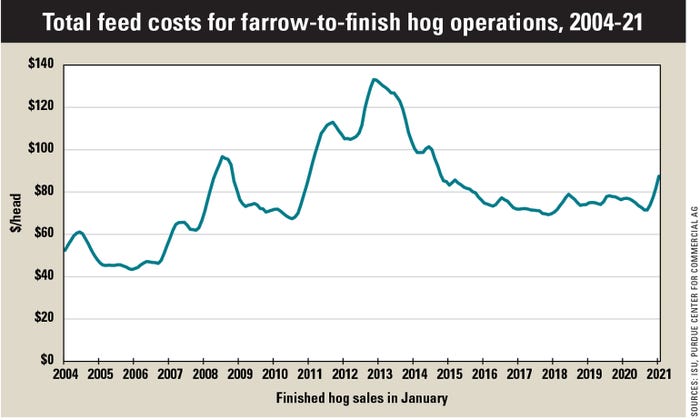March 19, 2021

Feed costs on hog operations have risen sharply since last summer. May 2021 Chicago Board of Trade corn futures prices hit their summer low settlement price last August at $3.46 per bushel. In early March, May 2021 corn futures were trading near $5.40, an increase of more than 50% in just seven months.
Feed costs share of total hog production costs since 2004 ranged from a low of about 43% in 2005-06 to a high of about 70% in late 2012 and early 2013, according to Iowa State University. On a per-head marketed basis, feed costs over that time frame ranged from a low of about $44 per head in 2005-06 to a high of more than $133 per head in 2012-13. Feed costs have moved up in the ISU data from an estimated $72 per head in August 2020 to over $87 per head for hogs marketed in January 2021.

Examining estimated farrow-to-finish hog production costs published by ISU from 2004 through early 2021 reveals that nearly all month-to-month production cost changes can be attributed to shifting feed costs. Note that the ISU data assumes all feed is purchased on an as-needed basis, without any feed price risk management.
Managing feed costs
The implication is clear. Effective management of total hog production costs requires management of feed costs.
It’s easy to say that feed costs need managing, but not quite so easy to say how they should be managed. That’s especially true as we enter the new crop year with much tighter crop supplies than in recent years. Crop prices could continue to rally further if crop production problems arise during the 2021 growing season.
Fortunately, there are several risk-management tools and strategies to consider. In addition to cash forward contracting of grain and meal supplies, you could consider long hedging in the corn and soybean meal futures market or the purchase of corn or soybean meal call options in place of long hedges in the futures market.
One of the challenges with using options to cover anticipated feed needs is the relatively large time value inherent in premiums for options that expire far into the future.
Short-dated options
A relatively new tool from the Chicago Board of Trade is short-dated new-crop options.
These are options on new-crop futures, such as December CBOT corn, that expire at various points throughout the growing season instead of late November, when the normal December corn options expire.
Since they expire sooner than regular options, the short-dated option buyer does not have to pay the large time value inherent in a premium for an option with an expiration date that’s far into the future. So, if you’re interested in protecting against a possible upward movement in new-crop corn or soybean meal futures during spring planting season or the summer growing season, consider adding short-dated new-crop options to your risk management tool kit.
Mintert is a Purdue University Extension ag economist and director of the Purdue Center for Commercial Agriculture. He writes from West Lafayette, Ind.
You May Also Like




